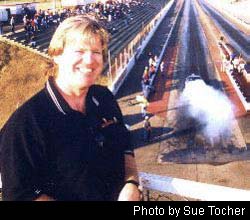
NITRO SPEC RULES NOT ALL BAD
NHRA protects racers from
themselves?
3/8/05

 t’s
easy to rail against the NHRA’s recent announcement
of an engine moratorium for its nitro classes—especially
since the sanctioning body went so far as to say it’s
part of developing an NHRA "Spec" (their quotation
marks) Top Fuel/Funny Car racing engine.
t’s
easy to rail against the NHRA’s recent announcement
of an engine moratorium for its nitro classes—especially
since the sanctioning body went so far as to say it’s
part of developing an NHRA "Spec" (their quotation
marks) Top Fuel/Funny Car racing engine.
First off, maybe I’m just being a prickly
editor type here, but why the quotes? To me it suggests
that they’re trying to soften the blow, as if putting
little marks around the word makes it some sort of ironic
equivalent. Just call a spade a spade, I say, and get on
with it.
The NHRA is moving toward mandating specified
engines in Top Fuel and Funny Car—period. In fact,
it wouldn’t surprise me at all if someday all engine
blocks, cylinder heads, intake manifolds, fuel injectors,
blowers, and even clutch systems for the nitro burners are
available only from authorized NHRA suppliers, just as critical
components like fuel and tires already are.
Obviously, purists and traditionalists aren’t
going to like this one bit. It takes away innovation, they’ll
cry; it mocks the history and nature of these classes to
go ever faster; it just won’t be real drag racing.
And a few years ago I would’ve agreed. Heck, I agree
even now, but the writing’s on the wall and something
has to be done to rein in both speed and cost. I don’t
know if spec engines are the answer, but at least NHRA is
taking a bold step to find out.
ADVERTISEMENT
 |
I’ve argued in this space before that
fans—even longtime, experienced, knowledgeable fans—can’t
tell the difference between a 300-mph pass and a 330-mph
pass by anything but the scoreboard, but I also firmly believe
that those big numbers are critical to the appeal of the
sport. So I have no problem with NHRA limiting engine technology
as long as we still regularly see those 320- to 330-mph
laps.
And I’m well aware the fuel classes
were built on record setting, but they were bound to reach
their limits. NASCAR found its limit in the late ‘80s
when it decided 200 mph would be its never-exceed speed,
and it’s maintained and enforced that decision for
all these years, obviously without losing ground in the
popularity race.
Normally, I can’t stand the “It-works-for-NASCAR-so-it’ll-work-for-us”
mentality, but in this case I think it really does work.
NASCAR refocused from record-breaking qualifying speeds
to hyping the setting of the field and presenting close
racing (thanks in large part to what have basically become
spec cars), and I don’t see why a similar shift in
focus would necessarily hurt nitro racing.

